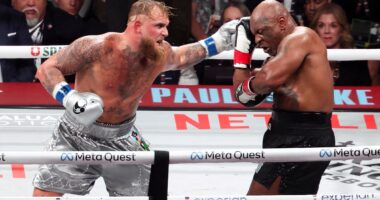Share to Facebook Share to Twitter Share to Linkedin Nike Paris Olympic athlete kits Courtesy of Nike Nike ended June battered and bruised. It just reported fiscal fourth-quarter revenues through May 31 were down 2% to $12.6 billion, with its Nike Direct revenues off 8%, dropping to $5.1 billion. It ended the year up 1% to $51.4 billion after reaching $51.2 billion in fiscal 2023 on 10% growth and a fourth quarter advance of 5% to $12.8 billion. With the company in the throes of a product cycle transition and shifting channel mix, it expects first quarter fiscal 2025 revenues to drop mid-single-digits and the first half to be down high single-digits. Nike was also hit with a class-action securities fraud lawsuit in U.S. District Court in Oregon for misleading investors about the success of its Consumer Direct strategy. The results played out predictably on Wall Street, where its stock tanked 23% in the last week of the month, starting Monday trading at $97.36 per share to close Friday at $75.37. According to Marketwatch, this is the company’s biggest drop in more than 20 years. In a research note, UBS analyst Jay Sole said, “Our key conclusion is there will be no quick rebound for Nike’s earning. We believe Nike is embarking on what will be a multiyear reset of its business in order to return to healthy top-line growth rates.” And Stifel analyst Jim Duffy shared much the same view but got even more pointed. “Management credibility is severely challenged and potential for C-level regime change adds further uncertainty,” as reported by Marketwatch.
MORE FOR YOU
‘House Of The Dragon’ Season 2, Episode 3 Recap And Review: Old Feuds And Bad Blood Ranked: The 30 Most Walkable Cities In The World, According To A New Report China Is Afraid Of International Law—And Planning A Counter-Offensive
Paris Olympics Calling
Despite the company’s severely depressed guidance, hope springs eternal at Nike’s Beaverton, OR headquarters. “The Paris Olympics offers us a pinnacle moment to communicate our vision of sport to the world,” said Donahoe in the recent earnings call. “We can’t wait to bring all this Olympics product to life across the Games and in more than 8,000 doors worldwide. And throughout, our brand storytelling will be bold and clear, with sport and athletes at the very center of it all, from brand voice to retail activations,” he added. Yet how this sportswear market leader let itself get so out of shape is the big question. “Compared to the market, which remains in growth, and compared to rivals, many of which are expanding sales at a rapid clip, Nike looks sluggish and unfit,” GlobalData’s Neil Saunders shared with Retail Dive.
Sluggish and unfit is no way for Nike to enter the Paris Olympic stadium.
First Quarter Bad, Worse To Come Acknowledging the company faces mounting headwinds – “We are taking our near-term challenges head-on,” Donohue said in a statement – the quarter wasn’t a total loss. Net income rose 45% to $1.5 billion. That was largely thanks to major budget cuts announced in December that included 2% job cuts impacting roughly 1,600 employees. Selling and administrative expenses were down 7% and cost of sales dropped 4%. Other positive signs during the quarter include wholesale revenues up 5% to $7.1 billion. Its performance products grew double-digits, powered by double-digit growth in basketball. However, the performance running category is still a work in progress, as it faces competition from emerging brands like On Running, up 21% in the latest quarter, and Deckers-owned Hoka, which grew 34%. These gains in profits, wholesale and performance products couldn’t offset the bad news. Sales of Nike lifestyle offerings declined, which Donohue said most strongly impacted its poor digital performance. Footwear, accounting for 68% of company revenues, dropped 4% in the quarter, to $8.2 billion. Sales were also down in its two largest markets. North America declined 1% to $5.3 billion and Europe, Middle East and Africa dropped 2% to $3.3 billion.





